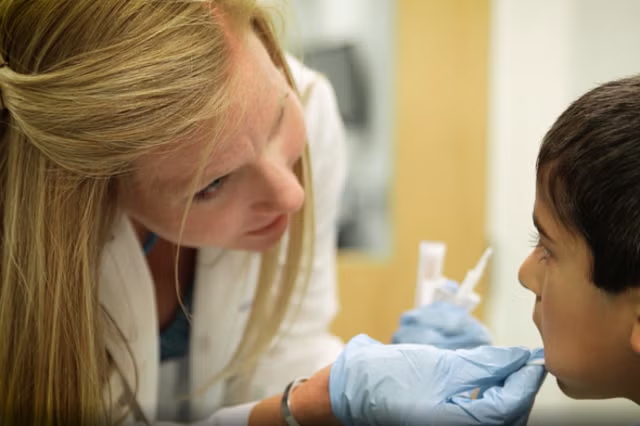A tick-borne disease dubbed "American malaria" is increasing in prevalence across the U.S., new research has found.
Cases of the disease—babesiosis—increased by about 9 percent every year between 2015 and 2022 in the U.S., according to a new paper in the journal Open Forum Infectious Diseases.
Additionally, four in ten of US babesiosis patients during this period were found to be infected with an additional tick-borne illness, such as Lyme disease.
"These findings suggest that clinicians should have a heightened vigilance of co-infection of other tick-borne illness among patients admitted with babesiosis," study co-author Paddy Ssentongo, an infectious disease fellow at Penn State Health Milton S. Hershey Medical Center, said in a statement.
"Ticks can carry other bacteria that cause Lyme disease and other tick-borne diseases like anaplasmosis and ehrlichiosis."
"Understanding the drivers, dynamics and control of endemic and emerging vector-borne diseases is critical for global health interventions," Ssentongo said.
Babesiosis is a tick-borne disease caused by microscopic parasites of the genus Babesia, which infect red blood cells. The main parasite responsible for babesiosis in the U.S. is Babesia microti, although other species can also cause the infection.
These parasites usually spread via bites from ticks, usually the black-legged tick (Ixodes scapularis), also known as the deer tick, which are the same ticks that spread Lyme disease.
In rare cases, babesiosis can be transmitted via contaminated blood transfusions, or passed from an infected mother to her baby during pregnancy or birth, according to the CDC.
"In the United States, spending time outdoors in certain areas can expose you to babesiosis. These areas include: New England (Connecticut, Maine, Massachusetts, New Hampshire, Rhode Island, and Vermont); New York; New Jersey; Wisconsin; Minnesota," the CDC explains.
Many people infected with Babesia may be asymptomatic or have mild flu-like symptoms, which may include fever, chills, sweating, fatigue, headache, muscle aches, and a loss of appetite. For elderly people, people with weakened immune systems, and people without a spleen, babesiosis can result in more severe illness, which may include hemolytic anemia (the destruction of red blood cells), jaundice, and organ failure.
"In the literature, the mortality rate of babesia ranges from 1.6 percent to 13 percent depending on the severity of the disease," the researchers wrote in the paper. "The mortality rate in our cohort was low at 1.4 percent"
The researchers analyzed data from TriNetX, a large, national database of clinical patient data from over 250 million individuals, and identified 3,521 individuals who had been infected with babesiosis between October 2015 and December 2022. Most of these cases occurred in the summer months.
It is thought that these rising cases are due to climate change, as changing temperatures, humidity and rainfall may have impacted the population and distribution of both the ticks and the deer that are important to the disease's transmission.
"Human babesiosis prevalence in the United States is on the rise, partly due to climate change influencing the distribution and population of vectors, and the predominant species is Babesia microti, which is endemic in the northeastern and northern Midwestern region," the researchers wrote in the paper.
This new paper also reveals that 42 percent of people infected with babesiosis were also infected with one or more extra tick-borne condition, which is a higher rate than found in previous research.
"The rate of coinfection with Borrelia burgdorferi [Lyme disease] was the highest at 41 percent, followed by ehrlichiosis at 3.7 percent and anaplasmosis at only 0.3 percent," the researchers wrote.
Thankfully, the researchers found that this co-infection did not lead to increased rates of illness or death, and if anything, the group who were infected with babesiosis alone had a greater mortality rate.
"Having both babesiosis and Lyme disease seemed not to be associated with worse mortality," Ssentongo said, noting the finding was surprising. "It's speculated that the concurrent presence of other tick-borne infections in the blood could alter the immune response by possibly 'boosting' it to effectively fight infections."
The researcher suggest that this may be due to the fact that the other tick-borne diseases are treated with doxycycline, which is usually prescribed for Lyme disease and other parasitic conditions, but not babesiosis.
"For patients with babesiosis, we add on doxycycline as we're investigating whether or not the patient has Lyme disease or other tick-borne diseases, and we've seen better outcomes at our medical center with this approach," Ssentongo said.
The only surefire way to avoid infection from these diseases is to avoid getting bitten by a tick in the first place.
"If you live in areas where babesiosis is endemic, mostly states in the Northeast and the Midwest, take precautions, especially during the summer months," Ssentongo said.
"Practice tick-bite prevention practices. Wear long-sleeved shirts and pants and light-colored clothes. Use tick repellant and check for ticks after spending time outdoors."
Do you have a tip on a science story that Newsweek should be covering? Do you have a question about tick-borne disease? Let us know via science@newsweek.com.
Reference
Ssentongo, P., Venugopal, N., Zhang, Y., Chinchilli, V. M., & Ba, D. M. (2024). Beyond Human Babesiosis: Prevalence and Association of Babesia Coinfection with Mortality in the United States, 2015–2022: A Retrospective Cohort Study. Open Forum Infectious Diseases, 11(10). https://doi.org/10.1093/ofid/ofae504
Disclaimer: The copyright of this article belongs to the original author. Reposting this article is solely for the purpose of information dissemination and does not constitute any investment advice. If there is any infringement, please contact us immediately. We will make corrections or deletions as necessary. Thank you.



